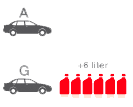
Regulation EC/1222/2009 provides that all tires placed on the market from 1 November 2012 shall display a rating label on energy efficiency, road grip and the level of external rolling noise. This label is similar to the one that appliances like washing machines, fridges, etc. have to wear.
Here we detail the different concepts and we will give you the keys so that when we change the tires we know what we buy.
 This symbol identifies rolling resistance, which directly impacts fuel consumption. Tires are classified by letters, from A (optimal performance) to G (worst). It is estimated that pneumatic nukes account for between 20 and 30 per cent of a vehicle's fuel consumption. So choosing a more energy-efficient tire can save between €170 and €230 annually. This symbol identifies rolling resistance, which directly impacts fuel consumption. Tires are classified by letters, from A (optimal performance) to G (worst). It is estimated that pneumatic nukes account for between 20 and 30 per cent of a vehicle's fuel consumption. So choosing a more energy-efficient tire can save between €170 and €230 annually.  Even though this tire will be more expensive than a lower-performance tire, the payoff is achieved from the second year, long before the end of its life. That's why, even if it seems that when you buy a low-efficiency tire, and therefore cheaper, you save money, in the long run you don't, because your car will consume on average 7.50 percent more than another, more efficient tire, with the increase in pollution and the environmental impact that this implies. Even though this tire will be more expensive than a lower-performance tire, the payoff is achieved from the second year, long before the end of its life. That's why, even if it seems that when you buy a low-efficiency tire, and therefore cheaper, you save money, in the long run you don't, because your car will consume on average 7.50 percent more than another, more efficient tire, with the increase in pollution and the environmental impact that this implies.
Obviously there are also other factors as important or more important for saving fuel as they are:
- tires inflated at the correct pressure: one in three vehicles drive at low pressure.
- axle geometria adjusted: lengthen the life of tires. improves the behavior of the vehicle, provides more in-gear stability and braking efficiency.
- efficient driving: paused and anticipating actions at the wheel.
At  we offer you the free pressure control service and a tire wear survey in case you need a vehicle alignment. we offer you the free pressure control service and a tire wear survey in case you need a vehicle alignment.
 Just as the first symbol refers to efficiency in terms of economics, it affects safety in terms of adherence on wet soil. Just as the first symbol refers to efficiency in terms of economics, it affects safety in terms of adherence on wet soil.
This concept values the ability of the tire to "grab" on the wet road.
Considering that the least rolling resistance and degree of adherence are two contradictory objectives between each other, we have to look for compromise between the two in order to get the balance in our preferences.
 The degree of adherence is also classified by letters, with the A offering the highest levels and the G offering the lowest. The degree of adherence is also classified by letters, with the A offering the highest levels and the G offering the lowest.
At  we have a wide range of tires covering a wide range of possibilities, from premium, mid-range to the cheapest. Contact us and we will recommend the right tire for your specific needs . we have a wide range of tires covering a wide range of possibilities, from premium, mid-range to the cheapest. Contact us and we will recommend the right tire for your specific needs .
 The third symbol refers to the environmental impact as it tells us the amount of noise pollution generated by the vehicle, i.e. the emission of external rolling noise. It classifies tires in relation to future European noise limits into three categories by measuring in decibels (dB) on a logarithmic scale, i.e. an increase of very few decibels, represents a big difference in noise levels. The third symbol refers to the environmental impact as it tells us the amount of noise pollution generated by the vehicle, i.e. the emission of external rolling noise. It classifies tires in relation to future European noise limits into three categories by measuring in decibels (dB) on a logarithmic scale, i.e. an increase of very few decibels, represents a big difference in noise levels. 
One (silent) sound wave is 3dB or more below the future European limit, two (moderate) sound waves, between the future European limit and 3dB below, and three (noisy) sound waves, above the future European limit.
So, with tire labeling, consumers will be able to quickly know the performance of each model, compare them with each other make the best choice. What it doesn't mean is a quality label that covers all aspects related to all the services. There are many additional factors of tire performance such as dry or wet maneuverability and stability, aquaplanning, durability, curve adherence, traction, etc. that are studied by construction brands and can use a wide range of criteria to demonstrate quality.
This regulation applies to all tourism tires, light commercial vehicles, heavy passenger and commercial industries, but retreaded tires, competition professionals, temporary or emergency-use and nails-equipped tires are outside their scope.
|